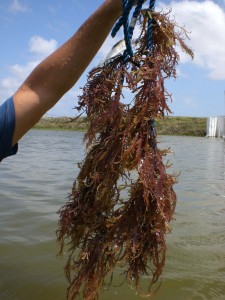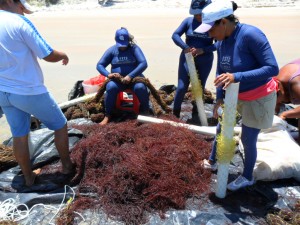 Project also breaks new ground in the search for partnerships
Project also breaks new ground in the search for partnerships
Talking about innovation, especially in regard to bioprospecting chemical molecules, brings to mind partnerships between universities and companies or drug development. The studies coordinated by Pio Colepicolo (IQ/USP) follow these lines, but open avenues for new partnerships: with fishing communities and shrimp farmers.
The project “Bioprospection studies on seaweed: the use of algal biomass as a source of new economically viable drugs and bioactive compounds and its application in the remediation of affected area” focuses on intertidal algae. Exposed to the elements during low tide, these algae live under extreme environmental stress, causing them to synthesize different chemical compounds to protect themselves. These organisms contain unique chemical compounds, with new and little studied molecules. Each algal species contains a set of different compounds that can be used in a range of approaches.
Research in this field branches into two lines: the study of seaweed biodiversity and bioprospection studies.
One group of researchers goes into the field to collect new specimens for identification, while the other remains in the laboratory to characterize chemical molecules and measure different biological activities, including antioxidant, anti-inflammatory, antibacterial, antifungal, and anticancer properties, as well as activity against neglected diseases such as leishmaniosis.
Once an activity of interest has been identified, the molecules are studied and can follow two possible routes, one of which involves using them as a model for synthesis. However, some molecules are difficult to synthesize and less economically viable if extracted from the algae. This is where the third element of this project comes into play, namely the partnership between researchers, fishing communities and shrimp farmers.
It is precisely the algae that contain difficult to synthesize molecules of commercial interest that are recommended for cultivation by members of the Rio do Fogo Algae Cultivation Association (Rio Grande do Norte state) and shrimp farmers in the region, with a range of direct consequences: increased income for coastal populations, less pressure on natural stocks of algae and better water quality where algae are cultivated.
Laboratory studies enable the selection of algal species with high biotechnological potential that are most suited to cultivation in the sea or shrimp ponds. These techniques produce new strains with biotechnologically interesting characteristics, particularly in the synthesis of pharmacological and industrial compounds, or favorable traits for ocean-based cultivation (disease resistant and herbivorous). In addition, these studies provide important information on species with high added value that contain difficult to synthesize molecules.
Research conducted by Professor Eliane Marinho Soriano of Federal University of Rio Grande do Norte has demonstrated the viability of algae cultivation for the Brazilian Northeast. At Rio do Fogo beach, algae is grown by around 10 women who traditionally collected seaweed to sell. Today they are an organized group under the AMAR (Rio do Fogo Mariculture Association) and receive assistance from the local city council in the form of a piece of land for drying the algae and a building as temporary headquarters, where equipment is stored. “On the Rio Grande do Norte coastline, seaweed was traditionally extracted by coastal communities (species of the genera Gracilaria and Hypnea) and has played an important role in the economy of these populations, supplementing their income”, explains Eliane Soriano. “The region’s economy is still strongly tied to fishing activities, which generally involve low levels of technology and high environmental impact, characterized primarily by collection that exceeds support capacity. Seaweed cultivation contributes to reducing pressure on natural stocks” that occurs through collection.
Algae cultivation combined with shrimp farming contributes to improving the quality of the water returned to the environment after use. Shrimp on these farms are fed high protein feed, resulting in high levels of nitrogen and phosphorus in the shrimp ponds. “Wastewater from shrimp farming is generally discarded into the environment, causing disturbance in the aquatic ecosystem”, highlights Pio Colepicolo. The conversion of residual nutrients into algal biomass and biochemical resources for commercialization increases the income of shrimp farmers and results in benefits that can offset production costs since, depending on the species, algae can have a wide range of industrial applications (such as pharmaceuticals, cosmetics, fertilizers or feed). On the other hand, shrimp and algae are harvested simultaneously, making the process easier.
Researcher Eliana Soriano emphasizes the importance of using native seaweeds as biofilters for sustainable aquaculture: “in terms of lowering the environmental impact, recycling waste within the system itself (on shrimp farms) is the best way to ensure sustainable aquaculture. In this respect, cultivating organisms with different trophic levels (such as shrimp, fish, oysters, algae etc.) has been identified not only as a technological approach that improves water quality (by removing nutrients), but also provides economic benefits by diversifying the organisms farmed.”
Some challenges remain, particularly in regard to the commercialization of cultivated algae. “In order to accomplish the commercial cultivation of algae, we need public policies aimed at the development of this activity”, explains Eliane Soriano.
By Érica Speglich

